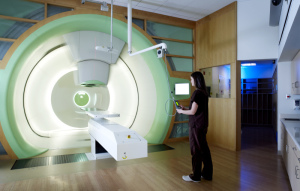by
John R. Fischer, Senior Reporter | February 22, 2022

A new technique could make proton therapy more affordable by eliminating the need for gantries
Researchers at Massachusetts General Hospital are experimenting with a technique that may enable gantry-free proton therapy for patients with head-and-neck or brain tumors.
If brought to fruition, the method could significantly reduce costs for building and operating proton therapy facilities and establish more affordable access for patients who would benefit from the treatment.
The technique combines pencil-beam scanning with robotic positioning and immobilization devices. Specifically, instead of the gantries supporting the application of the proton beam from both coplanar and non-coplanar directions, the proton beam would be fixed and the patient would be positioned in a chair that rotates to align with the beam and its delivery from coplanar angles,
according to Physics World.



Ad Statistics
Times Displayed: 109208
Times Visited: 6638 MIT labs, experts in Multi-Vendor component level repair of: MRI Coils, RF amplifiers, Gradient Amplifiers Contrast Media Injectors. System repairs, sub-assembly repairs, component level repairs, refurbish/calibrate. info@mitlabsusa.com/+1 (305) 470-8013
“We are currently investigating robust optimization of proton plans to evaluate a wider variety of cancers, and hope to publish these results soon. We envision that the gantry-less system could treat most solid tumors. Besides head-and-neck and brain tumors, we have already developed an immobilization devices for breast cancer. Other disease sites feasible for this treatment could include liver, lung and prostate cancer,” first author Susu Yan told Physics World.
Yan and her colleagues say that treatment without a gantry requires advanced PBS technology with small spot sizes that allow for dose modulation at each spot position, highly integrated and automated image guidance systems, and robotic patient positioning. After evaluating proton therapy plans for 4,332 cancer patients treated on gantries at MGH’s Francis H. Burr Proton Therapy Center, they found the majority could have been treated without one.
They then developed a prototype robotic patient positioning chair and combined it with a soft immobilization device that conforms to the patient’s body. They say the chair would be positioned in the center of the synchrotron with a horizontal beamline, in a 7x7 meter treatment room, with the patient sitting upright. It would be designed to rotate for the delivery of the coplanar beams, while an optical motion tracking system monitors the patient’s position.
Creating PBS treatment plans for seven patients with head-and-neck or brain tumors, including simple to complex plans, the researchers evaluated if plans with only coplanar beams could achieve the same dosimetric goals as those that rely on gantries. With in-house developed ASTROID software, they optimized the PBS plans to deliver a uniform dose. Dose-volume histograms, the homogeneity index of the target region and the mean dose, D2 (near-maximum dose) and D98 (near-minimum dose) of the target, and organs-at-risk were calculated for each plan.

